Highlights and Lessons learnt from the Portuguese Pilot
The recent developments in the AI world are increasingly drawing the attention of a plethora of industrial sectors. It is sufficient to see how the sudden advent and success of ChatGPT has immediately paved the way to numerous AI-powered technologies in different fields, e.g., telecommunications, finance, and health. The Energy industry is not left out, and it is growingly studying and analysing the way and to what extent AI could be applied to the sector, leveraging the enormous data streams that are collected nowadays.
For this purpose, I-NERGY is developing and implementing a demonstration pilot related to the electricity network in Portugal. R&D Nester (RDN), the research centre belonging to the Portuguese Transmission System Operator (TSO), is leading the pilot, which breakdowns into two different use cases:
- AI for enhanced network assets predictive maintenance, integrating off-grid data with condition-based monitoring;
- AI for network loads and demand forecasting towards efficient operational planning.
The former tackles the challenge of optimising the network assets maintenance, specifically focusing on circuit breakers. The aim is to develop a decision support tool fostering the use of a Condition-based Predictive Maintenance rather than inefficient time-based maintenance plans.
On the other hand, the second use case focuses on forecasting the network load at national level and the net load at the TSO/DSO interface, to improve accuracy and reliability of operational planning. Accurate forecasts are key to avoid significant imbalances between generation and demand, which is becoming more and more challenging due to the continuous increase of the penetration of non-dispatchable energy sources, both on the transmission and distribution side of the grid.
The pilot is at the final stage, and has already provided interesting solutions and results, as detailed below for both case studies.
AI technologies have proved to be an important resource for improving the maintenance strategies and the operational planning of Energy Networks. Nonetheless, it is of utmost importance to use them as a decision-support tool rather that a decision-making tool, to leave critical decisions to conscious and experienced operators, which shall always bear the associated responsibility.
AI for enhanced network assets predictive maintenance, integrating off-grid data with condition-based monitoring
The analytics service developed for the first use case processes data of events occurred in any electrical network (in COMTRADE format), providing a fully automated fault data processing, analysis, reporting system, and circuit breakers’ Remaining Useful Life (RUL) estimation. Specifically, it includes the submodules listed below and illustrated in the following service’s flowchart:
- Fault detection, which leverages signal processing techniques to detect whether an event is a fault or not, with an accuracy of approximately 94%;
- Fault classification, identifying the type of fault occurred (e.g., single-phase-to-ground, three-phase-to-ground), using Machine Learning (ML) (~96% accuracy);
- Incident reporting, which extracts incident statistics that are key to assets management divisions of System Operators;
- Predictive maintenance, predicting the Remaining Useful Life of a given circuit breaker, leveraging failure probability functions fitted on historical dataset of the events occurred, and identifying the corresponding maintenance recommendation.

The service includes as well a user-friendly Graphical User Interface (GUI), which is available in the AIoD Catalogue and can be tested after requesting credentials to R&D Nester. The figure below showcases the GUI, providing an excerpt of the output of a given fault analysis, in which a simulated event is correctly identified as a three-phase (3P) fault, and several key statistics are extracted, such as the fault detection time, elimination time and the maximum fault current.

In addition to this, the service stores all the processed faults into the Asset Management Database, consisting of a SQL database in which the events are grouped by the corresponding circuit breaker that experienced them. The database adopts traffic light labels (see figure below) for an effective visualization of the status of each asset, which is estimated through the Predictive Maintenance module and the failure probability threshold set by the user.

AI for network loads and demand forecasting towards efficient operational planning
The second use case is considering the forecasting of the Portuguese national load and of the net load of a specific TSO/DSO interface (the electrical power flowing form the transmission to the distribution side of a given substation) for the day-ahead operational planning. The most recent results concern the net load forecasting, applied to a specific case in which the net load is subject to a substantial change in the time-series pattern, occurring within a short timeframe. This is commonly referred as concept drift, and is illustrated below:

Such events may occur for different reasons, among which, for instance, the installation of a new Photovoltaic (PV) power plant at the distribution level, or the connection of a new large-scale consumer. The first case could even lead to reverse power flows, represented by the negative values in the figure, which may be quite challenging to predict by a model that has always been trained exclusively upon positive values.
For this reason, it is critical to develop and use models that, in addition to feature high forecast accuracy, are also able to adapt to new patterns and changes in the data. Under the scope of I-NERGY, the three approaches listed below have been considered:
- Long Short-Term Memory neural network-based model (LSTM);
- Ensemble models (XGB, DT, Lasso, SVR) based on Iterative Learning;
- Adaptive Random Forest based on incremental learning (Adaptive RF).
The three models were at first trained upon a large dataset that included significant drifts (Scenario 1), and then trained on a smaller dataset prior to the occurrence of the drifts (Scenario 2), with the aim to study the difference of the performance between the two cases. The second scenario was designed to analyse how the models react to new patterns and changes in the data that are not experienced during the training. The scenarios considered the same test dataset, which included one year of data that was not used for training the models.
The results showed that the Adaptive RF is the model that better adapts to the concept drifts, maintaining a Normalised Root Mean Squared Error (NRMSE) of 8.6% for both scenarios. On the other hand, the ensemble model presents the worst performance, with an NRMSE of 9.1% in Scenario 1 and 14.1% in Scenario 2. The performance’s drop from the first to the second scenario of the ensemble model indicates that it does not adapt well to new patterns unseen in the training dataset, contrary to the Adaptive RF. These results, described in detail in [1] , highlights the importance of using adaptive forecasting techniques when facing net load time-series characterised by concept drifts.
The figures below depicts the forecasting results of the three different models compared with the actual net load, for Scenario 1 and 2, respectively, and for a given timespan. Once again, it is possible to observe the Adaptive RF (in blue) is the model that better follows the actual net load patterns, especially for the second scenario.


For a full discussion on the results, please c.f. [1]2, in which the dataset is described in detail, as well as the techniques used to prevent overfitting and the additional evaluation metrics considered.

